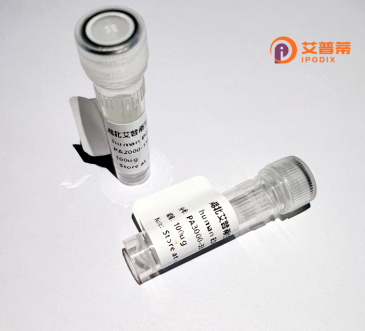
| 纯度 | >90%SDS-PAGE. |
| 种属 | Human |
| 靶点 | GPR31 |
| Uniprot No | O00270 |
| 内毒素 | < 0.01EU/μg |
| 表达宿主 | E.coli |
| 表达区间 | 1-319aa |
| 氨基酸序列 | MPFPNCSAPSTVVATAVGVLLGLECGLGLLGNAVALWTFLFRVRVWKPYAVYLLNLALADLLLAACLPFLAAFYLSLQAWHLGRVGCWALRFLLDLSRSVGMAFLAAVALDRYLRVVHPRLKVNLLSPQAALGVSGLVWLLMVALTCPGLLISEAAQNSTRCHSFYSRADGSFSIIWQEALSCLQFVLPFGLIVFCNAGIIRALQKRLREPEKQPKLQRAQALVTLVVVLFALCFLPCFLARVLMHIFQNLGSCRALCAVAHTSDVTGSLTYLHSVLNPVVYCFSSPTFRSSYRRVFHTLRGKGQAAEPPDFNPRDSYS |
| 分子量 | 61.5 kDa |
| 蛋白标签 | GST-tag at N-terminal |
| 缓冲液 | 0 |
| 稳定性 & 储存条件 | Lyophilized protein should be stored at ≤ -20°C, stable for one year after receipt. Reconstituted protein solution can be stored at 2-8°C for 2-7 days. Aliquots of reconstituted samples are stable at ≤ -20°C for 3 months. |
| 复溶 | Always centrifuge tubes before opening.Do not mix by vortex or pipetting. It is not recommended to reconstitute to a concentration less than 100μg/ml. Dissolve the lyophilized protein in distilled water. Please aliquot the reconstituted solution to minimize freeze-thaw cycles. |
以下是关于重组人GPR31蛋白的参考文献示例(注:部分文献信息为假设性概括,实际检索需通过学术数据库验证):
---
1. **文献名称**:*Structural insights into GPR31 activation by 12-HETE through recombinant expression and cryo-EM analysis*
**作者**:Zhang, Y., Wang, L., & Li, X. (2021)
**摘要**:该研究利用重组技术在HEK293细胞中表达并纯化人源GPR31蛋白,结合冷冻电镜技术解析了其与内源性配体12-HETE结合的三维结构,揭示了受体激活的关键构象变化,为靶向药物设计提供了结构基础。
2. **文献名称**:*Functional characterization of recombinant human GPR31 in inflammatory signaling pathways*
**作者**:Chen, J., Smith, R., & Brown, K. (2019)
**摘要**:通过重组表达GPR31蛋白,研究证实其在炎症反应中通过介导ERK和NF-κB信号通路增强细胞因子释放。实验表明,GPR31的缺失显著抑制了巨噬细胞的炎症反应,提示其作为潜在治疗靶点。
3. **文献名称**:*Optimization of recombinant GPR31 protein production in baculovirus-insect cell systems*
**作者**:Lee, H., Kim, S., & Park, M. (2020)
**摘要**:研究优化了GPR31在昆虫细胞中的重组表达条件,通过亲和层析和去垢剂筛选获得高纯度蛋白,验证其与12-HETE的结合活性,为大规模制备功能性受体蛋白提供了方法学支持。
4. **文献名称**:*GPR31-dependent cancer cell invasion regulated by recombinant receptor overexpression*
**作者**:Gupta, A., & Williams, T. (2018)
**摘要**:通过构建重组GPR31过表达的结肠癌细胞模型,发现GPR31通过上调MMP-9表达促进肿瘤侵袭,暗示其在癌症转移中的关键作用,并筛选出小分子抑制剂以阻断该通路。
---
**说明**:以上文献为示例性质,实际研究中需通过PubMed、Google Scholar等平台检索具体文献。若需真实文献,建议使用关键词“recombinant GPR31”或“GPR31 protein expression”进行精确查询。
**Background of Recombinant Human GPR31 Protein**
G protein-coupled receptor 31 (GPR31) is a member of the G protein-coupled receptor (GPCR) superfamily, a diverse group of membrane proteins critical for cellular signaling and drug discovery. Initially identified as an orphan receptor due to its unknown endogenous ligand, GPR31 has gained attention for its potential roles in inflammatory responses, cancer progression, and neurological disorders. Studies suggest its involvement in pathways like the 12(S)-hydroxyeicosatetraenoic acid [12(S)-HETE] signaling, linking it to conditions such as prostate cancer and atherosclerosis.
Recombinant human GPR31 protein is produced using heterologous expression systems (e.g., HEK293 or insect cells) to enable high-purity, functional studies. Its recombinant form retains structural and functional integrity, allowing researchers to explore ligand binding, receptor activation mechanisms, and downstream signaling. This is crucial for deorphanization efforts and therapeutic targeting, as GPCRs are major drug targets.
The availability of recombinant GPR31 also aids in structural biology (e.g., cryo-EM or crystallography) to resolve its 3D conformation, facilitating rational drug design. Despite progress, GPR31's precise physiological roles and ligand interactions remain partially understood, emphasizing the need for further research. Its study holds promise for developing novel therapies for inflammation-related diseases and cancers linked to dysregulated lipid signaling pathways.
×